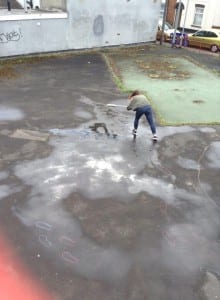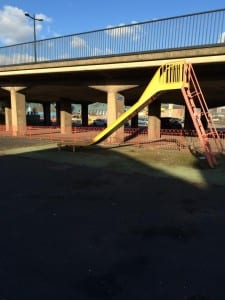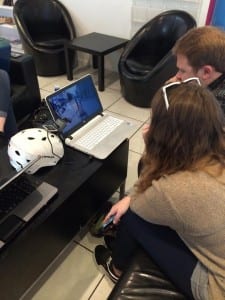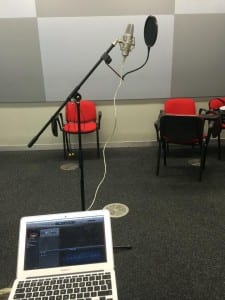Framing statement
For the past three months, my group and I have been developing our piece of site specific performance, entitled yOUR Journey. The experience we created revolves around the idea of time; what it means to us, how it changes and, perhaps most importantly, the terrifying thought that there is nothing we can do to stop it. Our performance took audience members on an audio/visual journey through the heart of Lincoln, whilst simultaneously walking the same route in real life, to an abandoned and desolate playground, in which the audience is greeted with an interactive performance, showing the changing of time with chalk drawing and water (lots of it). Our performance lasted just over half an hour, with 22 minutes of that time being taken up by the video journey and walk to the site.
When the audience arrived in our space, we initiated ten minutes of drawing on the floor of the park, with chalk, things that symbolised changes in time, the passage of time from past to present to future, and things related to the idea of a park; childlike game such as hopscotch. Throughout these ten minutes, we would randomly wash off part of the chalk with water, and then someone else would start to draw over these parts again. This symbolised the changing nature of time, and what it does to a space. The water represented time, washing away the old and making way for the new, and the chalk being drawn over the same spot showed the present and future, something replacing this past area. At the end of the ten minutes, I stood up, tapping each of our group members on the shoulder, signalling an end to the piece by standing and freezing, staring at the work we had done.
Throughout the entire performance, we, as performers, remained silent, instilling an emptiness in our experience that represented the harshness of time as it manipulates its environment. We were particularly fond of the idea that as human beings we cannot perhaps explicitly see time change, but nevertheless it happens, whether we like it or not. The silence therefore showed this idea through us as performers; you cannot hear us or notice us as explicitly as if we were vocal, but our actions are still prominent and explicitly. In some respect, actions speak louder than words.
Kaye talks of site-specific work as work that ‘might articulate and define itself through properties, qualities or meanings produced in specific relationships between an ‘object’ or ‘event’ and a position it occupies’ (Kaye, 2000, 1). In our piece of work then, the ‘object’ was the park, the ‘event’ being the passage of time, and the meanings produced being that time is manipulative and ever changing, without us noticing. The park is a place that had clearly been vibrant in its past, is now desolate in its present, and shows promise for regeneration in the future.
Analysis of Process
The process began with our initial finding of the performance space, our park. Our original arrival at the park was as a result of a drift, something suggested to us in our initial briefing from our tutor. Kris Darby refers to drifting as ‘a type of walking that places emphasis on the senses in which one is led by in-the-moment thoughts, feelings, and sensations that prompt a liquid-like drifting through the city.’ (Darby, 2013, 50) and so this is what we as a group did; exploring the city of Lincoln with no real motivation to go in any set direction until we found an area of interest. This ‘drifting’ through the city led us to our first discovery, the Lincoln Equitable Cooperative Industrial Society.
The Lincoln Equitable Cooperative Industrial Society Lmt. is an old building situated not far from our final performance space. We were first drawn in by its intriguing architecture and obvious history, and so noted it as a possible performance space. After researching further into the building and area with my group, we soon realised it would be almost impossible to create a performance in this space, as it was structurally complicated, leaving almost no room for exploration of the space and ultimately no room for a performance to be created. We did find some archived files surrounding the building, pinning its inception back to 1861, which made it even more disheartening that we couldn’t use the space, as the history was so rich and relatable to Lincoln culture (industrial aspects to the city).
This defeat led us swiftly on to explore more places we had seen earlier on our drift, resulting in the finding of our final site, the park. I had read in Nick Kayes book, Site-Specific Art, that ‘Rather than mirror the orderliness of place, space might be subject not only to transformation, but ambiguity’ (Kaye, 2000, 5) and it was with this knowledge that our group took particular interest in the park we found as a ‘space’. Not only did it seem to display a transformation, as the initial park structures such as swings and roundabouts has been torn down, but it also showed ambiguity, as there was no revelation as to why this had happened, or what the plans for the park were. We found the idea of a park being abandoned and torn down particularly enticing, as it invited an exploration of what was their before, something only our imagination could envisage. From this our desire to explore ‘time’ as an idea was born.
As we continued to develop ideas, this idea of something related to time was the only thing set in stone. With our brief being to create an audio related experience, myself and my four other group members spent some time exploring archives and online resources for audio clips encompassing the idea of past, present and future in Lincoln. We stumbled across a short snippet of audio from 1935 of a man talking about the history of Lincoln and its architecture, something we already found interesting before engaging with this module. He spoke factually about the history of Lincoln, something we knew we wanted to include in order to lay foundations for the present and the future. For example, the audio clip stated that:
“We have our housing problem, but the people of Lincoln had when William the conqueror destroyed 166 houses to make room for a mighty castle. Its strength and position brought much fighting to Lincoln, a fact which is no doubt used by local disarmament advocates.” (British Pathe, 2014)
Once we had the starting point of an audio clip describing the past history of Lincoln, we began working on our full script for the audio tour, which would consist of this audio snippet as well as our own ideas surrounding what is happening and what could happen in Lincoln. As our initial brief was to create an audio tour style performance, this was what we began working on exclusively. We spend a week or so each writing something that we thought we could bring in to the experience, again to do with time, be it the past present or future. We then compiled all of our work into one script ready to record and edit into one smooth audio journey. As we began to compile audio tracks together, our tutor suggested a change that would make our performance bolder and more unique. Instead of taking our audience on a simple audio tour to the location, she suggested creating a video of the chosen route to accompany the audio. The idea was a simple adjustment, but fit perfectly with our exploration of time, as audience members could see a ‘past’ Lincoln on the video, be it a very recent past, compared to a ‘present’ Lincoln when they are actually walking the route. This new premise also aligned perfectly with our fondness of Blast Theory, another company ‘using interactive media, creating groundbreaking new forms of performance and interactive art’ (Blast Theory, 2015) that influenced us heavily.
Danny, one of our group members, had acquired a GoPro that we realised would be perfect for recording the video aspect of our journey. The first draft version of our video was shot with the GoPro, attached to Danny’s head with a helmet mount. The reason we used this piece of technology and the helmet mount was so that we could get a realistic looking video with the most ease possible. By having the video shot from the head level of a person, it helps reinforce the idea that what they are watching is from somebody’s eyesight, making the whole video seem more personal and immersive; the video is from the viewers perspective. We wanted the video to be immersive to emphasise the idea that the passage of time and the changes it brings is happening to everyone, including the viewer. After a few logistical hiccups, including encountering a suspected drug deal near our location that obviously meant we had to re-shoot our footage, we had a final video, clocking in at 23 minutes.
With the initial video idea sorted, and the production taking form, we turned our focus as a group to what would actually happen in our space when the audience arrived. We knew that whatever we did, we wanted some form of interaction with our audience. McAuley proposes that ‘If the performance event can be defined as what takes place between performers and spectators in a given space and time, then the spectator has to be seen as a crucial and active agent in the creative process’ (McAuley, 2000, 235). With the stimulus that we chose being the passing of time, it would be idiotic not to include some form of interaction, as this would be the most powerful way of representing our ideas.
After meeting with the group and discussing ideas about what could be performed in our space, the suggestion of using some form of paint to draw pictures and phrases was put forward. As well as drawing these scribbles on the floor, it was proposed that would would wash away these artworks with water, making way for a new canvas to be painted on. Not only did this idea resonate with each of us on a creative level, we realised that the ideological and theoretical side of our original proposal would perfectly fit this performance. The washing away of the paint would be a somewhat repetitive action, symbolising the future washing away the ‘present’, turning it into the ‘past’, making way for a new ‘present’. The performative aspect would be sporadic and in a way quite rhythmic, representing the often sporadic nature of time.
We began the recording stage of our process. As a musician, I own a studio quality condenser microphone which I was willing to use to record all of our audio tracks ready to compose into one smooth audio file for the video. As quality was something we wanted to ensure throughout all of our recording, we found ourself a small room in the main university building, with a low amount of reverb. We took it in turns recording separate sections of the script we had crafted earlier in the process, and, once recorded, applied equaliser to ensure the highest quality recording. This meant stopping the audio from clipping, taking down the high end to depress the ‘hiss’ and boost the mid frequencies to ensure a tonally smooth sound. A few of our tracks had to re-recorded due to errors in the dialogue and technically, including too much ambient noise in the background as well as interference from phones. We recorded on a second date in the back room of one of the group members’ houses, and although the sound environment was different and perhaps more reverberant, we managed to fix it in post, making it incredibly similar in sound to the original set of recordings. With the audio recordings done, we were ready to start merging these with the video.
Editing our video took little to no time at all in comparison to the rest of our process; all that was needed to do was align the right parts of audio with the right moments in the video. For example, we knew that at a certain point in the 1935 audio track there was mention of the Stonebow on the high street, and so we wanted this to line up with the moment in the video where the Stonebow could be seen. This was not only because it makes for an easier watch a a viewer, but also because it makes the whole journey easier to dissect as a listener, as the audience member can see what is being talked about. We really wanted to get this sense that what was being talked about is what the viewer can see at that moment. After layering a royalty free music track that we found online over the sections of no dialogue, we were finished editing the video. This meant that most of our performance was finished, all that was left was rehearsal in the space and the final performance.
The final rehearsal came in the form of a playful exploration of the park as a site. We knew that we wanted to use the only piece of playground equipment that was still standing, the slide, especially when ‘objects on the stage tend to merge into the background, and they become meaningful only when handled, looked at, or referred to’ (McAuley, 2000, 91). We decided to use the slide as a basis to incorporate another repetitive action; sliding down it as children would. We made this decision as we felt as a group that it would help bring out some of the character of the park and actions that would be found in a park, juxtaposing with the desolate, unused nature that it currently resonates. We gave some slight structure to our performance by making sure that once we had each finished a drawing on the floor, we would then proceed to go down the slide, only then returning to carry on drawing. We had to also figure out the logistics of how we could supply enough water to keep washing away the audience and performers’ artwork in this rehearsal, but this was easily accomplished. As one of our group members house was nearby, we filled buckets with water at the house, walking them to the park to leave as a pre-set for the performance. We knew that on the day, it would therefore be easy to top up with water if need be.
Evaluation
The final performance was surprisingly exhausting but also incredibly satisfying, in terms of personal gratification as well expanding my understanding of performance instead of typical acting. We didn’t receive any audience aside from Conan and Karen, but this is mainly due to the weather on the performance date that, whilst staying clear for our marked performance, decided to take a turn for the worst shortly after. The audience we did have, however, interacted in exactly the way we would have hoped.
The journey to our site seemed to go perfectly, with the audience arriving exactly on time as we had hoped. As audience interaction was such a huge part to our performance in the actual space, we were unsure whether anyone would actually step forward and join in, but this fear was quickly settled when both of our audience members took some chalk and joined in. Both seemed to be enjoying themselves, and fully involving themselves with the idea of our piece. At the end of our piece, we had an alarm set to go off, prompting the end of the piece but also symbolising the fact that we do not have any choice as to when things happen in time, they just do. However, this alarm did not go off as loudly as we had hoped, and so although we could still end the piece, the audience members probably didn’t notice it, which is a shame. The chalk worked incredibly effectively on the floor, especially when it was wet, but we had already seen how well this worked when we tested the chalk previously. However, in hindsight we should have purchased some thicker chalk sticks, as the ones we used kept snapping under the slightest pressure. This wasn’t a problem as such for the performance, more of a change if we were to do it again, as it would prevent having to use more chalk than we needed.
One piece of criticism we received was regarding the volume of the audio track on the video, as Conan’s experience was slightly hindered as he couldn’t hear what was being said. We managed to track this down to a hardware fault, as Karen’s experience of the same video was completely fine. To avoid this in the future, we would make sure to double check every piece of hardware, including the earphones to make sure that no individual experience would be hindered. In hindsight, we should have perhaps used over ear headphones to cancel out surrounding noise too but this was not possible for our deadline due to expenses. If we could do the performance again, there are some things we would change even though we are very pleased with how effective our experience turned out to be. One thing we would adjust would be the quality and volume of the audio in the video, as with a louder audio level, we would be able to avoid the problem of not hearing much. The sound quality was fine we felt, but again, we could have reached a higher level of quality had we had better software and perhaps the use of a studio space.
Overall, I feet that yOUR Journey was an incredibly effective piece of site-specific performance, successfully representing our ideas surrounding time and the changing nature of physical and emotional elements in these changes. By interacting with our performance, I feel I have expanded my horizons when it comes to different forms of art and performance, now knowing that it doesn’t have to just be ‘acting’. Spaces and areas have different background and different meanings, and site-specific performance helps to display this in a way that is accessible to all, no matter how much knowledge you have of the space previously, and this is an incredible thought.
3,059 WORDS
Blast Theory (2015) Our History and Approach. [online] Brighton: Blast Theory. Available from http://www.blasttheory.co.uk/our-history-approach/ [Accessed 8 May 2015].
British Pathe (2014) City of Lincoln (1935). [online video] Available from https://www.youtube.com/watch?v=fNKuYdFAuAY [Accessed 9 May 2015]
Darby, K. (2013) Framing the Drift and Drifting the Frame: Walking with Wrights & Sites. New Theatre Quarterly, 29 (1) 48-60. Available from http://ejournals.ebsco.com/Direct.asp?AccessToken=5WF494FTRPFWQS9NURS6FRYR4RRWTR9Q6U&Show=Object&ErrorURL=http%3A%2F%2Flinksource%2Eebsco%2Ecom%2Ferror%2Easpx [Accessed 8 May 2015].
Kaye, N. (2000) site-specific art: performance, place and documentation. Oxon: Routledge.
McAuley, G. (2000) Space in Performance: Making Meaning in the Theatre. United States: The University of Michigan Press.
Wilson, N. (2015) Final Performance. [photo].
Wilson, N. (2015) Finding the Site. [photo].
Wilson, N. (2015) Footage Review. [photo].
Wilson, N. (2015) Recording Audio. [photo].




